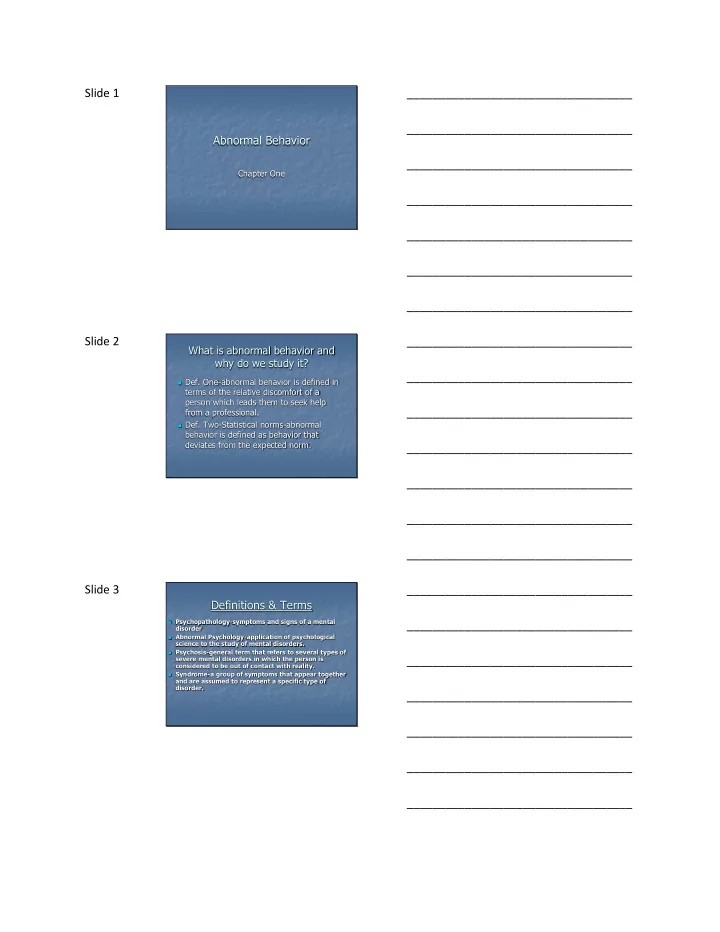

Slide 1 ___________________________________ ___________________________________ Abnormal Behavior ___________________________________ Chapter One ___________________________________ ___________________________________ ___________________________________ ___________________________________ Slide 2 ___________________________________ What is abnormal behavior and why do we study it? ___________________________________ Def. One-abnormal behavior is defined in terms of the relative discomfort of a person which leads them to seek help from a professional. ___________________________________ Def. Two-Statistical norms-abnormal behavior is defined as behavior that deviates from the expected norm. ___________________________________ ___________________________________ ___________________________________ ___________________________________ Slide 3 ___________________________________ Definitions & Terms Psychopathology-symptoms and signs of a mental ___________________________________ disorder Abnormal Psychology-application of psychological science to the study of mental disorders. Psychosis-general term that refers to several types of severe mental disorders in which the person is ___________________________________ considered to be out of contact with reality. Syndrome-a group of symptoms that appear together and are assumed to represent a specific type of disorder. ___________________________________ ___________________________________ ___________________________________ ___________________________________
Slide 4 ___________________________________ Additional Terms Epidemiology-the scientific study of the frequency ___________________________________ and distribution of disorders within a population. Incidence-the number of new cases of a disorder that appear in a population during a specific period of time. Prevalence-the total number of active cases, both ___________________________________ old and new, that are present in a population during a specific time period. Co-morbidity-the presence of more than one condition with the same period of time. Psychiatrist-branch of medicine concerned with the study and treatment of mental disorders. ___________________________________ Psychologist-concerned with the application of psychological sciences (behavioral) to the assessment and treatment of mental disorders. ___________________________________ ___________________________________ ___________________________________ Slide 5 ___________________________________ Designations and Training Clinical Psychologist- 5+ years of graduate study, one year internship — trained in the use of psychological assessment ___________________________________ procedures and psychotherapy. Doctor of Philosophy- PhD major emphasis on research methods. A doctoral dissertation is required. Doctor of Psychology-PsyD-greater emphasis on practical skills of assessment and treatment. Does not require a dissertation ___________________________________ Counseling Psychology-(PhD) more applied field that focuses on training assessment and therapy (Dissertation usually required). Social Worker- profession concerned with helping people ___________________________________ achieve an effective level of psychosocial interaction. Requires a masters degree in social work, based less on a body of scientific knowledge and more on a commitment to action. ___________________________________ ___________________________________ ___________________________________ Slide 6 ___________________________________ Historical Context Greek- Hippocrates ___________________________________ Middle Ages ___________________________________ Industrial Revolution (1600-1800) Development of the Asylum (1833) ___________________________________ Development of Psychiatry (1844) ___________________________________ ___________________________________ ___________________________________
Slide 7 ___________________________________ Methods for studying Abnormal Behavior ___________________________________ Case Study Correlational Study ___________________________________ True Experiment ___________________________________ ___________________________________ ___________________________________ ___________________________________ Slide 8 ___________________________________ Recognizing the Presence of the Disorder ___________________________________ Set of Characteristic Features No definitive lab tests ___________________________________ Impairment of every day funtion. ___________________________________ ___________________________________ ___________________________________ ___________________________________
Recommend
More recommend